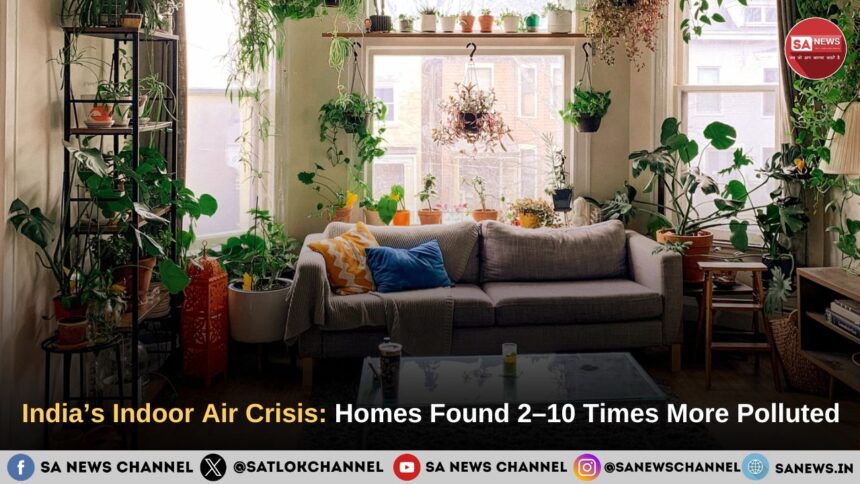In a country already struggling with toxic outdoor air, two major research insights have exposed an alarming truth: India’s indoor spaces may be far more dangerous than the pollution people see outside. New findings from Dyson engineers and a first-of-its-kind Indoor Air Quality (IAQ) Index developed by BITS Pilani, NIT Warangal, and IIT Jodhpur show that Indian homes can carry 2 to 10 times higher pollution levels than the air outdoors often without residents realising it. From cooking fumes to industrial dust leaking indoors, and from winter smog to stubble burning, experts warn that Indian households are facing an underestimated and largely invisible health threat.
- Key Takeaways: India’s Hidden Indoor Air Pollution Emergency
- Indian Homes Are Not as Safe as People Assume, Say Experts
- India’s First Indoor Air Quality Index Reveals Deeper Crisis
- Household Activities and Seasonal Trends Amplify Indoor Pollution
- Delhi-NCR’s Outdoor Pollution Intensifies Indoor Exposure
- What Experts Recommend for Indian Homes
- Why India Needs Indoor Air Standards Now
- Towards a Breathable Future: What India Must Recognise Now
- The Transformative Spiritual Knowledge of Tatvdarshi Saint Rampal Ji Maharaj Ji
- FAQs on India’s Indoor Air Pollution Crisis
Key Takeaways: India’s Hidden Indoor Air Pollution Emergency
- Indian homes may carry 2–10 times more pollution than outdoors, as shown by Dyson’s internal studies and the new India-specific Indoor Air Quality Index.
- Major indoor pollutants include cooking fumes, cleaning agents, VOCs, dust from furnishings, tobacco smoke, and outdoor traffic emissions entering through gaps.
- Researchers from BITS Pilani, NIT Warangal, and IIT Jodhpur created India’s first IAQ Index using AHP-based pollutant severity weighting.
- Delhi-NCR and several cities repeatedly touched “Very Poor” (301–400) and “Severe” (401–500+) AQI levels, worsening indoor air contamination.
- Poor ventilation traps particulate matter (PM2.5, PM10) after routine indoor activities like cooking and cleaning.
- Seasonal influences such as winter smog, Diwali fireworks, and stubble burning further degrade indoor air quality.
- Experts urge national indoor air standards, ventilation norms, public awareness campaigns, and widespread adoption of HEPA-based air purifiers.
- Misconception busted: Closing windows does not prevent pollution. In many cases, indoor air becomes even more polluted.
Indian Homes Are Not as Safe as People Assume, Say Experts
While urban India continues to fight hazardous outdoor air, indoor air pollution remains largely unacknowledged, despite being equally or more harmful. According to Dyson engineer Alex Hudson, invisible pollutants quietly accumulate inside homes through routine activities.
Hudson explains that outdoor pollutants from vehicle emissions to industrial fumes enter through open windows, doors, and even tiny structural gaps. Once inside, they mix with pollutants produced by everyday activities like cooking or even lighting candles. This dangerous combination can make indoor air up to ten times more polluted than outdoor air.
He notes that people spend up to 90% of their time indoors, constantly inhaling odourless, invisible contaminants without realising the long-term health consequences. Hudson highlights tobacco smoke, traffic emissions leaking indoors, and even dust released from soft furnishings as major contributors.
India’s First Indoor Air Quality Index Reveals Deeper Crisis
India now has its own Indoor Air Quality Index, thanks to researchers from BITS Pilani, NIT Warangal, and IIT Jodhpur. Their study, published in the Royal Society of Chemistry journal, confirms that Indian homes often record 2–5 times higher pollution levels than outdoors.
Lead researcher Dr. Atun Roy Choudhury states that people wrongly assume their homes are safe spaces. The team found that daily activities, combined with poor ventilation and seasonal pollution, elevate indoor particulate levels dramatically.
Faculty mentor Prof. Sankar Ganesh stressed the need for India-specific benchmarks. He explained that Indian homes differ in structure, cooking styles, festival practices, and climate, factors that global indoor standards fail to address. The study therefore used the Analytical Hierarchy Process (AHP) to assign severity weights to pollutants such as PM2.5 and PM10, creating an indoor air scale relatable to India’s environment.
Household Activities and Seasonal Trends Amplify Indoor Pollution
The research highlights that particulate matter spikes sharply during daily tasks like:
- Cooking
- Cleaning
- Using chemical-based products
- Burning incense or candles
- Poor waste disposal
Due to weak ventilation systems, these pollutants remain trapped indoors for hours.
Seasonal factors especially winter smog, stubble burning, and Diwali fireworks force even more pollution indoors. Many households living near construction sites, renovation zones, or landfill areas face additional spillover contamination. Researchers warn that methane emissions from unsegregated waste and large dump yards also infiltrate indoor spaces, posing climate and health risks.
Delhi-NCR’s Outdoor Pollution Intensifies Indoor Exposure
Data from the Central Pollution Control Board (CPCB) and SAFAR (System of Air Quality and Weather Forecasting And Research) for 2025 shows that Delhi-NCR and several Indian cities frequently reported AQI levels in:
- Very Poor (301–400)
- Severe (401–500+)
Some regions saw readings crossing 450, triggering health advisories. Experts clarify that outdoor air directly affects indoor air, making indoor spaces unsafe even when windows are closed.
What Experts Recommend for Indian Homes
Alex Hudson advises a multi-layered approach, including:
- Cutting smoke at the source
- Ventilating during early mornings or late evenings when outdoor air is cleaner
- Using exhaust fans to remove humidity and fumes
- Adopting low-VOC cleaning products
- Avoiding synthetic fragrances
- Keeping homes shoe-free with microfibre doormats
- Deep cleaning carpets using HEPA-equipped vacuums
- Decluttering to reduce dust settlement
He states that a high-performance HEPA air purifier remains the most effective way to remove ultrafine particles and allergens, especially in cities with inconsistent air quality.
Dyson continues to innovate in filter lifespan and system efficiency, ensuring long-term purification performance.
Why India Needs Indoor Air Standards Now
The research teams urge policymakers to:
- Establish national indoor air quality guidelines
- Enforce ventilation standards in buildings
- Launch awareness campaigns on clean cooking and waste management
- Promote energy-efficient housing designs
Dr. Choudhury emphasises that indoor air quality is not yet part of India’s public health conversation, but must be prioritised urgently.
(News source:Indianexpress.com)
Towards a Breathable Future: What India Must Recognise Now
India’s indoor air crisis is no longer invisible. With research revealing that homes can be 2 to 10 times more polluted than the outdoors, the country must recognise the silent threat growing inside its living spaces. From scientific evidence provided by Dyson to the first-ever India-specific Indoor Air Quality Index, experts unanimously warn that without improved ventilation, better awareness, and strong national guidelines, millions will continue inhaling harmful pollutants unknowingly. As outdoor AQI worsens across cities, safeguarding indoor air becomes not just a health precaution but a national necessity.
The Transformative Spiritual Knowledge of Tatvdarshi Saint Rampal Ji Maharaj Ji
In today’s age, when deforestation, pollution, plastic waste, stress, jealousy, and moral decline have become routine, humanity is experiencing the true onset of Kalyug. Trees, the homes of countless animals, birds, and insects are being destroyed. People have become self-centered, driven by greed, ignoring nature, animals, and even fellow humans. This imbalance in human character and environment ultimately disrupts Earth’s natural system, including rainfall, seasons, and clean air.
According to the divine spiritual knowledge of Tatvdarshi Sant Rampal Ji Maharaj, when humans keep the Supreme God happy through righteous conduct and devotion, nature automatically remains balanced. Good rainfall, healthy crops, clean air, and overall harmony are signs of divine satisfaction. But when humans drift away from morality, compassion, and spiritual wisdom, nature responds through pollution, climate imbalance, floods, droughts, and rising diseases.
The unique knowledge of Tatvdarshi Sant Rampal Ji Maharajnot only reveals the identity of the Complete God but also transforms the human mind. By listening to His Satsang, a person naturally learns what is right and what is harmful towards the environment, society, animals, and even oneself. This spiritual wisdom shapes us into better humans, encourages compassion, and teaches us to live in harmony with nature.
Everyone must listen to the Satsang of Tatvdarshi Sant Rampal Ji Maharaj Ji at least for a month, whether they choose to follow it or not because it provides clarity, peace, and the right direction in this chaotic age.
For more authentic spiritual knowledge, visit www.supremegod.org
And watch Kalyug mei Satyug ki shuruaat part 1,2 and 3 available on Factful Debates on youtube.
FAQs on India’s Indoor Air Pollution Crisis
1. Why is indoor air in Indian homes more polluted than outdoors?
Indoor air mixes cooking fumes, dust, VOCs, traffic emissions, and trapped outdoor pollutants, making pollution levels 2–10 times higher.
2. What did the new India-specific Indoor Air Quality Index reveal?
Developed by BITS Pilani, NIT Warangal, and IIT Jodhpur, it shows Indian homes often have 2–5× higher particulate levels due to cooking and poor ventilation.
3. How does outdoor AQI affect indoor air quality?
Very Poor or Severe outdoor AQI directly seeps indoors through gaps and ventilation, worsening indoor pollution even with closed windows.
4. What are the most harmful indoor pollutants in urban Indian homes?
PM2.5, PM10, VOCs, tobacco smoke, cleaning chemicals, dust, and traffic emissions entering through windows and openings.
5. How can Indian households reduce indoor air pollution?
Ventilate during cleaner hours, use HEPA purifiers, deep clean regularly, avoid synthetic fragrances, and adopt low-VOC products.









